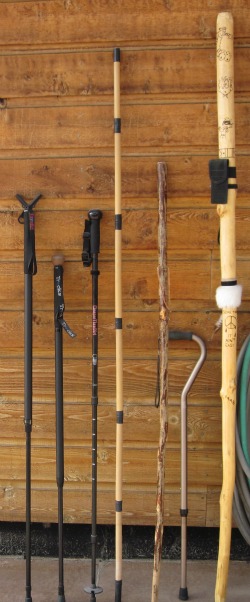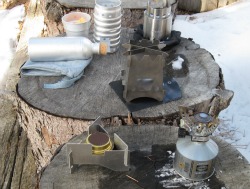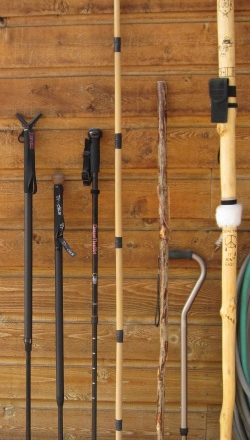If you read my post on 7 Tips For Your Bug Out Bag, considered this part II. Many posts on Bug Out Bags out there in the blogosphere talk about specific items being better than others. I prefer comparing ideas instead of whether a Mora is better than a Bushman for low budget survival, boy would that be a fun debate Survival Gear is great, it makes life in the backcountry easier, but mindset and skills keep you alive. So we try and find a happy balance like most aspects of living. Much of this post will be review for you experienced types, but it never hurts to be reminded. For you newly awakened survival minded Americans, welcome to the party. I will try and not repeat too much from the last post, there will some cross-over and expanding of ideas.

By Pineslayer, a contributing author to Survival Cache & SHTFBlog
Sweat Happens
 The biggest rookie mistake when hitting the trail is being over dressed. You will heat up quickly, don’t be afraid to stop and shed a layer early on. Too much sweat can cause problems fast, drenched clothes, dehydration and generally being uncomfortable in your clothing. Choosing the right clothing it is your first defense against Mother Nature. The old saying ‘Cotton Kills’ is pretty good advice. I love my cotton clothes and wear them often when working or hiking, but they have no place in your survival kit. It takes forever and a day to dry out. One plus for cotton is hot and dry environments where it can shine, it just depends on where you are and time of year. Now a 50/50 blend is not so bad. Most BDU’s are this blend and they wear great and dry out fairly fast. I have wool blends that are very comfy and so are the polyester base layers. Do your homework before betting your life on any clothes. I can’t say enough good things about BDU style clothing. Ripstop durability, pockets, and there are some good non-camo ones out there if you are looking for a more Gray Man look. The debate of natural fiber and synthetic will not be solved here today. Both have their pro’s and con’s. I use both and my kit has both. We should happy that we have so many choices. Last piece of advice, think about being able to layer when choosing your survival clothing. I prefer loose clothing over tight fitting mostly for ease of movement and airflow. The only tight fit should be your base layer.
The biggest rookie mistake when hitting the trail is being over dressed. You will heat up quickly, don’t be afraid to stop and shed a layer early on. Too much sweat can cause problems fast, drenched clothes, dehydration and generally being uncomfortable in your clothing. Choosing the right clothing it is your first defense against Mother Nature. The old saying ‘Cotton Kills’ is pretty good advice. I love my cotton clothes and wear them often when working or hiking, but they have no place in your survival kit. It takes forever and a day to dry out. One plus for cotton is hot and dry environments where it can shine, it just depends on where you are and time of year. Now a 50/50 blend is not so bad. Most BDU’s are this blend and they wear great and dry out fairly fast. I have wool blends that are very comfy and so are the polyester base layers. Do your homework before betting your life on any clothes. I can’t say enough good things about BDU style clothing. Ripstop durability, pockets, and there are some good non-camo ones out there if you are looking for a more Gray Man look. The debate of natural fiber and synthetic will not be solved here today. Both have their pro’s and con’s. I use both and my kit has both. We should happy that we have so many choices. Last piece of advice, think about being able to layer when choosing your survival clothing. I prefer loose clothing over tight fitting mostly for ease of movement and airflow. The only tight fit should be your base layer.
Keeping a Clean Camp
Are you a clean freak? Does everything have a place in your home? If the answer is yes, then you have a good starting point. If the answer is no, you need to get your mind in order. This will be hard for some people, but bear with me. When car camping you spread out and set up your outdoor home, some backpackers are guilty of this too. In a survival/bug out situation this can lead to big problems. Not only is it easier to lose track of essential gear, but if you need to move quickly any hesitation to grab stuff could mean dire consequences. Use your gear when needed then put it away.
A clean camp also means hiding waste. Even in tense, stressful times, the effort must be made to make it harder to track you. Although these principles are recreational based, if you think tactically they make sense too. Expanding on the tracking thing, next time you hit the trail, try to leave no tracks. See if you can walk on hard surfaces, rocks in or close to the trail. Then see if you move without making any noise. These are skills that need to be practiced before they are needed.
Too Staff or Not To Staff
A hiking stick is more than a fun toy. Choose the right one and you have a tent pole, doggy back-off stick, rifle monopod, snake stick, fishing pole, fighting Bo, spear…the list is only limited by your imagination. When crossing a stream or log it can really steady the balancing act, especially when you have a pack on. Trekking poles are used by more older hikers than younger ones, for good reason. Using your arms to help climb a hill, when your knees have a lot of miles on them, just makes sense. Anyone who has spent anytime with a heavy pack can attest to the fact that going downhill when tired can be tricky, poles can save you from a fall.

There are many tents out there that rely on trekking poles to reduce pack weight. If you carry a poncho for your shelter, than a pole is very useful. The only downside I can think of is if you are carrying a rifle, then a staff would be a problem, but there are collapsible ones too. The picture shows one that has removable tops, from a smooth ball top to notched rifle rest, think of the possibilities. Frog gigger, torch, or just maybe some decoration that improves your spirits.
Lastly, laws notwithstanding, sword canes. I have not looked into them much, but I can see a place for them with older folks in your group. I have seen some very cool looking ones and who doesn’t like a long sharp piece of steel.
Carrying The Essentials
I’m talking about the stuff you use everyday, all the time. There are many acronyms for these items, I prefer Canterbury’s 10C’s system. It just is simple and easy to teach to others. Anyway when bugging out, scouting a route, looking for resources, there will be times when you shed your pack to crest a hill to look for something. The reason will be to save energy and get there quicker, maybe you are looking for a place to go to the bathroom. If you get turned around, caught in an ambush, or just get hurt, do you want to be without everything?
Many packs have a removable lid that converts to a waist pack. It is my opinion that your essential gear should go in there and go with you everywhere, to bed, to the bathroom, everywhere. If your pack doesn’t have one or it just isn’t right for the job, there are many other ways to have that stuff on you. Pockets, on your belt, chest rig, any combination of these. Lay out the things you want on your body at all times, the rest goes in the ruck. Find the system that works for you and is comfortable so you never leave them behind, never.
Here are a few options that I have, all are designed to work with a backpack. I use to use a small hydration pack strapped to the top of my large pack, it worked well. I moved away from that in an attempt to lighten the load. It saved a pound or two, but the option is still very good. Waist packs come in so many designs that it will make your head spin, I have settled on some vintage pieces probably because they are more rugged than current recreational offerings. Ribz packs are a great option too. I have one, it is light and comfortable, I wouldn’t call it rugged, but it isn’t fragile either.
There are packs that come with an attached smaller pack. The ones in my collection are on the heavy side. If you have ever worn a ILBE main pack with attached assault pack, you know what I mean. That set-up weighs in at around 15 lbs, empty. Now it is as rugged as anything on the planet, but so are the men who carry them. There are some great travel luggage packs with zip off day packs, very gray man units. The downside is that the suspension isn’t as robust as more purpose driven packs. Kinda going off course here.
My carry systems leans towards pocket kits, cargo pockets that is, and waist packs that store inside the ruck, or a combination. My main INCH bag has a Ranger RACK chest rig that is set up for survival and not battle. It really does work great. Find a way that works for you, wear it, use it and don’t be afraid to admit defeat and try something else. When you are humping down a trail and can’t turn back, you are stuck with the system you have.
Running a Cold Camp and Stealth
 Bottom line is if you are bugging out drawing attention to yourself is a bad idea. At some point you will need to rest, hydrate, eat. Starting a campfire is like sending up a flare every couple of minutes. Water is heavy, you should have a days supply on you, after that you will need to acquire more. Get a good filter, have some purification tablets too. For the sake of this section, we will assume you have access to water, if you don’t, change your plan or route. Now you can boil water, how will you do that? There are so many stoves out there to choose from that you can spend days, weeks reading about them and trying to decide. Why a stove vs. just building a fire? Smoke and light, both bad in this situation. A stove limits both, a good stove can virtually eliminate them.
Bottom line is if you are bugging out drawing attention to yourself is a bad idea. At some point you will need to rest, hydrate, eat. Starting a campfire is like sending up a flare every couple of minutes. Water is heavy, you should have a days supply on you, after that you will need to acquire more. Get a good filter, have some purification tablets too. For the sake of this section, we will assume you have access to water, if you don’t, change your plan or route. Now you can boil water, how will you do that? There are so many stoves out there to choose from that you can spend days, weeks reading about them and trying to decide. Why a stove vs. just building a fire? Smoke and light, both bad in this situation. A stove limits both, a good stove can virtually eliminate them.
A stove that requires fuel other than wood will become a liability at some point, but in the short term they very useful. Alcohol stoves are easy, no moving parts and if you spill the fuel it doesn’t stink up your clothes forever. Trangia’s are bombproof and are just plain cool. Downside is that they are not great at altitude and in extremely cold temps. A small wood burning unit is the way to go for long term. 180 Tactical, Emberlit, SoloStove, Swiss Ranger Volcano, and many others are available at affordable prices. All put out very little smoke, if any, after a minute when they get heated up. Also, in the honorable mention category, are the stoves that take propane/butane mix canisters. Easy to use, instant heat, no smoke, little flame, and the stove itself is small and light. The fuel isn’t really expensive, but impossible to improvise when you run out.
The last case for having a stove in this scenario is cooking meat on the trail. Squirrel sushi doesn’t sound good to me. Staying warm in a cold camp is the only other problem. Dress appropriately. Pretty much common sense, right? Scrutinize your clothing and have a good sleep system. Everyone’s area and tolerance to cold is different, but don’t skimp here. Good clothing can be had for a song at thrift stores. Don’t expect to get everything at one time there, but stop in every time you are driving by. If you only find one piece a week, it adds up. I haven’t bought a shirt, coat, boots, or pair of pants at a department store in well over a decade. I am a cheapskate, but I don’t wear cheap clothing. Example, I was in S. Carolina this summer, drove by a Goodwill, went in, with much ribbing from the in-laws, walked out with a pair of Levi’s cargo pants, looked new, for $5 and tax. You never know what you will find. My coffers are filled with quality gear too, all from thrift stores.
How Did I Get On This Subject?
Pick your lay up position wisely. Use the terrain to your advantage by letting nature obscure your camp. You can use a little field craft too. Some downed branches can be used around your site for camouflage. A depression in the ground may be all you need, just make sure it isn’t in a runoff area. Surveillance after you set up is key, try to pick a spot that you can see approaching trouble. If you plan on being in a spot for more than a day, keep your travels to a minimum and don’t leave tracks to and from the camp. In a grassy area, picking a different route every time can help to not leave a trail. So as always, please leave your ideas about this stuff in the comment section. Sharing ideas just make us better.
by Pineslayer






